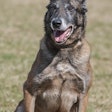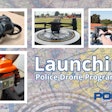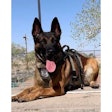As the law enforcement community is well aware, police service dogs have proven to be a valuable tool to law enforcement over the last 15 to 20 years.
The key word to this statement is "tool."
Police service dogs are not perfect. They are not machines. They do make mistakes or the handler can misread what the dog is trying to tell them.
The biggest reason a police service dog fails during a SWAT operation is the lack of education and training with the SWAT team. Many SWAT's personnel are not aware of their K-9's capabilities in certain situations and some of the handlers have never been trained in SWAT tactics.
There is also that dirty three-letter word: Ego. Some SWAT team members think if a police service dog is used during a SWAT deployment, the police service dogs will take their jobs away. Many other SWAT members fear that the police service dog will get hurt or killed during an actual deployment.
Speaking as a handler, I must keep in mind that my dog is merely a tool in the SWAT arsenal. As much as I love my dog, he is replaceable, whereas police officers are not. I would prefer that my police service dog be hurt or killed during a SWAT deployment instead of an officer.
Handlers must see the "big picture" and realize that police service dogs are an expendable asset.
SWAT teams need to remember that the primary function of a police service dog during a SWAT operation is to "assist." In almost every instance, once a SWAT team sees what a properly trained police service dog can and cannot do, they will begin to use their dogs on a regular basis.
K-9 Facts
Before we go any further, I need to discuss a few basic facts about K-9s. One must keep in mind that dogs do not think or reason like human beings. Dogs react out of instinct or they react out of their training.
The reason why dogs are so quick is because it takes approximately 1/40 of a second for a dog to see something and then react to it. If a dog has never been exposed or trained on how to react to a certain situation, the dog will react out of instinct.
Unfortunately, the reaction may not be the response we were looking for.
Drives of a Dog
Dogs have three basic drives. These drives are: Play Drive, Defense Drive, and the Prey Drive. The Play Drive is needed for a narcotics dog. Some people refer to this drive as the Fetch or Retrieve Drive. A play drive is not needed in a patrol/ SWAT dog.
The Defense Drive is present in every dog. The Defense Drive is also known as fight or flight. When there is a lot of pressure put on the dog, does the dog stay and fight, of does the dog flee?
The Prey Drive is something that is a must in every patrol or SWAT dog. The dog must have the willingness to want to go out and hunt/ search for a suspect. A good patrol/ SWAT dog should have a proper balance of prey and defense drive. Ideally, you would want to have approximately 80 percent prey and 20 percent defense in any police service dog.
Senses
How does a dog function in his environment? A dog functions through his senses. Those senses being his sense of smell, eyesight and hearing. There are many evaluations on the strength of a dog's nose. The most common estimation is a dog's smell is approximately one million times greater than that of humans.
The dog's sense of hearing is also very acute. I have heard, however I do not know if it is true, that a dog can hear a heartbeat up to 25 feet away. I know through experience at certain times during a search my dog will stop and listen. His hear canters from side to side and his ears start to rotate like radar. When my dog starts searching again he usually goes to the area where the suspect is hiding.
Unlike humans, dogs do not see in color like we do. Because of this they have a depth- perception problem. Dogs do, however, pick up movement very easily. It is possible for a person to see a suspect who is partially hidden from view and the dog does not see the suspect at all. Once the suspect moves, the police service dog should have almost immediate suspect ID.
[PAGEBREAK]
Selection of K-9 SWAT Handlers
There are several handler characteristics that must be taken into account before the selection of a K-9 SWAT handler. One thing to keep in mind is that not every handler is suitable to be a K-9 SWAT handler. You need to look for someone who not only has experience with dogs but also understands and works will with them.
Just because a person has been a handler for five to 10 years does not mean they really know anything about dogs.
You also need to have a handler who has control over his police service dog. If the handler has never been to a basic SWAT school he needs to be sent prior to being deployed with the team.
Selection of a SWAT Dog
There are several traits that should be considered when looking at a police service dog for SWAT. One of the first things you want to look for is a dog with confidence. It helps immensely to have a dog that is sociable and like to be around other individuals. You also need to have a dog that is comfortable working in tight and small quarters.
It goes without saying, you need to have a dog that is not bothered by loud sounds, such as gunfire or flash bangs and a dog that has the correct balance of Prey and Defense Drives.
It is also pertinent that a SWAT dog has street experience. It is very difficult to take a new dog- or even a new handler- fresh out of a basic K-9 school and put him in a special weapons and tactics environment.
There are too many unknowns for both the handler and the dog.
Training
People think it is difficult to train a police service dog. All it really takes is time, patience and understanding on how a dog learns. A dog learns through "formed association" or "repetition." You can teach a dog almost anything as long as you are consistent with you training and you break the exercise down into small, simple exercises.
In order to prepare a police service dog for SWAT, the dog and the handler need to be exposed to as many different situations as possible. The handler needs to know how the dog will react in each situation, and be able to correct the behavior if the response of the dog is incorrect.
Before beginning training with the SWAT team, the handler needs to train with the police service dog first. Once the handler knows that they police service dog will react correctly in a given situation, he can discuss with the SWAT team what is expected of them. Once the SWAT team knows what is expected from them, it is time to bring the handler, police service dog, and SWAT team together for training.
Arrest Team
In the past, a police service dog was primarily used on the perimeter of a SWAT operation. Through proper training, you can use a police service dog as part of an arrest team. You need to have a minimum of two SWAT personnel with the K-9 team. Each person on the arrest team must know his or her proper assignment. These different assignments include who will give the commands to the suspect, handcuffing the suspect, covering the K-9 officer, and who is going to walk the suspect away.
There are many things that the K-9 handler must think about while being on the arrest team. The K-9 handler must know the locations of every perimeter officer.
They may come a time when the suspect becomes uncooperative or flees. The K-9 handler needs to know where the other perimeter officers are located so he can decide whether to release his police service dog after the suspect, or let the other perimeter officers take him into custody.
Having a plan and communicating this plan is an essential part of an arrest team. The K-9 handler has to communicate with his perimeter officers what he is going to do in each possible situation prior to the incident happening.
He needs to inform the perimeter officers if the suspect runs in a certain direction for them to remain motionless and quiet because he is going to deploy the dog. However, if the suspect runs in another direction, he needs to inform them that he is not going to send the police service dog and for the perimeter officers to take the suspect into custody.
Deployment
There are several other uses for police service dogs during SWAT deployment. Some of these are: clearing attics, under a house, tunnels, crawl spaces, thick shrubs, bushes, stairwells, buildings, open areas and in a gas environment.
When it comes to formulating a plan for a SWAT deployment, the K-9 handler should be included in the planning stages. If the K-9 handler is present during the planning stages, he could interject where the dog could be used. By not having the K-9 handler present, the SWAT team may want the K-9 to accomplish a specific task expecting, perhaps unrealistically, that the dog will be able to complete the task.
When everyone is brought together for the briefing, the plans may have to be changed if the K-9 can not perform as expected. This will waste valuable time in re-formulating a plan.
When it comes to building searches during a Swat operation, the approach is sometimes overlooked. The police service dog can be placed at the head of the congo line. Through proper exposure and training most dogs can be taught to walk straight on a 15 or 20 foot long line. This way the police service dog can walk "point" and clear the danger area in front of the SWAT team as they approach the point of entry. By having the dog walk point, if the police service dog comes across a person hiding, the dog will alert the SWAT team prior to their arrival.
[PAGEBREAK]
Entry
Prior to deploying a police service dog on a SWAT operation, the handler needs to know his departmental policy. In what situations does the handler have to give a K-9 announcement prior to deploying the dog? The handler also has to decide whether to give the dog a search command or a bite command.
It is also important for the SWAT team to realize there may be times when the handler may not have his gun out as he is deploying the dog. It would benefit the handler to inform the SWAT team of this tactic. The SWAT team needs to assign a person to the K-9 handler as the back-up officer. This officer goes everywhere the handler goes.
There will be times when the SWAT team may want the police service dog to be deployed from the back of the congo line. Through proper training and exposure this will not be a problem.
However, whenever possible, the best way to deploy the dog would be the place the dog in the threshold of the door. By placing the dog in the threshold, the team is giving the dog a chance to use his senses.
The dog is able to survey the area in front of him by using his nose, eyes and ears. By leaving the dog in the threshold to survey the area is approximately 30 to 45 seconds, this will give the dog ample opportunity to pick up any human scent that is blowing toward the point of entry.
On the initial entry of the dog, the K-9 should be used to only clear approximately 15 to 20 feet into the building. Limiting how deep the dog will go into the building will let the SWAT team know if there was anybody lying in wait just inside the entryway.
The easiest and quietest way to limit the distance of dog will enter into the building is with the use of a long line. The long line could be either a retractable or free and long line.
One of the tactics that K-9 handlers like to use, but SWAT is uneasy with, is the handler watching the police service dog search. Even though we trained for the perfect alert, this is not always the case in real life. In real life, the only alert we may get is the dog showing a change in behavior in a certain area. If we are not able to watch the dog search and are not able to see this change in behavior, we cannot tell the SWAT team that the dog has an interest in this area and to be extra careful in that area.
The way I got my SWAT team to allow me to watch my dog was through the use of a bulletproof shield. This gave me the ability to watch my dog as he searched. Once my dog has searched the area, I recall him to me and take him to the rear of the congo line.
SWAT now makes entry into the location and does a detailed search of the area that the police service dog has searched.
Once the SWAT team has completed their detailed search and has secured the area, they then decide in which direction to continue the search. Once they have decided which direction they want to go, it is time for the police service dog to be called up from the rear and clear the danger area prior to the SWAT team searching.
Once the K-9 has searched the area, the handler again retreats to the back of the congo line with his dog and the SWAT team now makes a detailed search in the area just cleared by the police service dog.
Searching with a SWAT team is no more than a "leap frog" from room to room.
Outside Searches
On any type of outside search one of the first things any good K-9 handler determines is the wind direction. Whenever possible, the police service dog should be deployed into the wind or on some type of crosswind. The scent of a suspect travels with the wind in a "cone" pattern, which the dogs are able to easily follow.
This scent pattern is known as a scent cone. By using the wind to your advantage the suspect can be located safely and quickly.
On any outside area search, the handler needs to determine how he is going to deploy his dog. He needs to decide whether he is going to release his dog into the search area off leash, direct the dog to certain areas to search or use a long line to clear the areas as they go. Once again, before actual deployment of the police service dog, it is important to let the dog survey the area and use his sense.
[PAGEBREAK]
Locating a Suspect Out of Sight
I mentioned earlier that communication is the key to any successful SWAT or police operation. There are situations that must be discussed prior to every deployment so there are no mistakes. One situation is what arrest technique is going to be used when a suspect is located out of sight.
When a suspect is located, everyone's first reaction is to rush into the area. The problem with rushing into the search area is there might be numerous areas which have not been cleared. You need to take your time and clear those areas before you get to the area where the suspect has been located.
The handler needs to decide when to recall the police service dog. I strongly suggest the handler not recall the dog until he is able to pinpoint where the suspect is hiding.
If you recall the dog before you can see when the suspect is hiding, the suspect will have a chance to move to a different hiding spot. Once the handler is able to tell the SWAT team exactly where the suspect is hiding, the job of the police service dog is done. SWAT takes over from here.
Now, there may be instances where the SWAT team wants the dog and the handler to stay up from with the team. There may also be times when the team wants the police service dog to retreat to the end of the congo line.
All of these different situations must be discussed prior to the actual incident so that everyone on the SWAT team is "playing off the same sheet of music."
Police Dog Biting a Suspect
When a police service dog has located and is biting a suspect out of sight, everyone wants to rush in and observe the incident. However, this is not a very safe maneuver. You need to remain calm and do not rush into the location. You must take your time and clear the area in front of you as you go.
You may want to try and call the suspect to your secure location while the dog is biting the suspect. Pain can be a very good motivator. This may save time and effort in clearing several rooms before you actually get to where the dog is biting the suspect.
Because the dog is used to the handler's voice, the handler should be the one giving orders to the K-9 and the suspect. Through proper training, the dog can become accustomed to other people yelling at the suspect; however, for some dogs this might take some time.
Once the SWAT team has a visual on the dog and the suspect, there are several different arrest techniques that can be used. One of the biggest questions is, "When do you take the police service dog off the bite?"
You must also consider who is going to do the handcuffing. Different techniques that are used by different departments are, for the K-9 to be released from a distance, before the suspect is handcuffed and before the handler has actual physical control over the K-9. This could cause some problems with rebiting and the suspect fleeing.
Some departments will call the K-9 and suspect back to their point of cover and safety. When the SWAT team has control of the suspect, the K-9 handler will then take physical control of the dog and have the dog release the bite.
Some departments will have the K-9 handler handcuff the suspect while the dog is on the bite to insure control of the suspect. Whatever arrest techniques your department uses make sure the SWAT team knows which procedure is going to be utilized before the incident.
Main Points
In closing, I would like to reiterate a few areas. In order for police service dogs to be effective during K-9 SWAT deployment, they must have proper training and exposure with the SWAT team.
If your K-9 unit does not train with your SWAT team, do not deploy your police service dog during a SWAT operation. You are only looking for failure and possibly open your department to a liability lawsuit for "failure to train."
Communication and planning are also key elements to any successful SWAT operation. Make sure team members know their assignments and other people's assignments in case something happens.
There area numerous situations that can happen on any actual SWAT deployment and all of them need to be covered prior to actually being deployed.
Brad Smith is an 18-year veteran of the West Covina (Calif.) Police Department and designed and implemented the first and only P.O.S.T.- certified K-9 SWAT school in the states of California and Arizona. Smith has been a K-9 handler for 12 years, 10 of those as a SWAT team member. He is a graduate of the California P.O.S.T. Master Instructor Program and has taught thousands of K-9 handlers throughout nine western states. Smith also competes, wins and judges internationally and regionally in K-9 competitions. This is his first contribution to POLICE.












